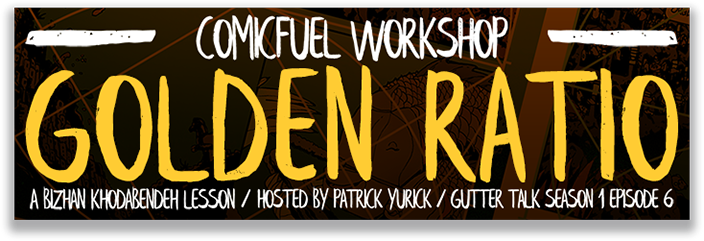The internet has transformed independent comics and given creators an easy way to get their stories out to the public. There are a lot of different ways to publish your work online, but two of the most popular are WordPress and WordPress running ComicPress. (more…)
Posts Tagged: making comics
How to Gain New Fans at Conventions
So, you got a table at a convention? At an expo? A fest? An artwalk? Next to some kid’s lemonade stand? Doesn’t matter. That’s great! Now you have the opportunity to gain new fans of the work you’re putting out into the world. But manning a convention table is not a passive event. As much as we’d all love to just sit there and “let the work speak for itself”, it’s rather annoying to see artists with their heads down hoping someone will walk up to make a purchase.
#TalkingComics w/ Kevin Cullen: Bizhan Khodabandeh and Mark Luetke on the Infinite Canvas Comic System
If comic revolution is the name of the game here at Making Comics (dotCom), then our good friends Mark Luetke and Bizhan Khodabandeh are risking it all on the front lines. Their weapon of choice? An awesome new way to read webcomics. The Kickstarter project is called INDOOR/OUTDOOR: A New Infinite Canvas Comic System and it’s one hell of an investment for anyone who owns and operates a webcomic. Designed to scroll from page to page in a smooth, streamlined style, the Infinite Canvas is shaping up to be a very powerful tool with a gorgeous design. I reached out to Mark and Bizhan with some questions about their project and what it means for webcomics in the future. (more…)
Panel Layout: The Golden Ratio
Announcing our FREE Golden Ratio Workshop designed to expand on the concepts introduced in the article below!

Excitement would understate how I felt when I read Frank Santoro’s articles on the first appearance of the Golden Ratio in Hergé’s TIntin comic pages. Santoro used grid overlays to explain comic composition with geometric shapes in a way that could be easily understood by a graphic designer, like myself. (more…)
Comic Review Checklist, Part 2: Words
Hi again everyone! This is the second part of my comic review checklist, which has three parts: everything that relates to the “flow” of the pages, everything that relates to the words on the pages, and then everything else. This is part two! (more…)
18: How To Start Making Comics (Round Table) – MakingComics.com Gutter Talk Podcast
We recently wrapped up a four week long Massive Open Online Course (MOOC) called “Get A Grasp!” that covered everything from ideation to pitching your idea to networking. Each week we also had a live online panel with amazing artists and professionals in the industry. What you’re about to listen to is the Week 1 panel, which came out with all cylinders firing. The topics, the guests, the conversation, all of it was well worth the price of admission. Which, oh by the way, was free. Just like this podcast. All in the name of art and comic creation. Alright, bring it in. Group hug!
Podcast: Play in new window | Download (Duration: 1:11:43 — 65.7MB) | Embed
Subscribe: Apple Podcasts | Email | RSS
You Have a New Idea! So What?
No one ever says to the surgeon, “You know, I think I’d really like to try performing a kidney transplant sometime.” Meanwhile, there is no professional or aspiring professional writer who has not heard, at least once, upon explaining his or her vocation, “You know, I think I’ve got a novel in me, somewhere.” It’s infuriating. (more…)
17: Jason Brubaker, Nate Simpson, & Daniel Lieske (Classic #2) – MakingComics.com Gutter Talk Podcast
It’s the last Friday of the month so we hit the way-back machine and go way back- what? This interview is only a couple years old? Oh. Uh, well, can I say we hit the shortly-back machine? Yeah? Great. Let’s try this again.
It’s the last Friday of the month so we hit the shortly-back machine- hmm, still doesn’t sound right. You know what? Just cue the wavy flashback lines. This is part 1 of the Nate Simpson interview with Jason Brubaker and Daniel Lieske. Maestro!
Podcast: Play in new window | Download (Duration: 59:56 — 54.9MB) | Embed
Subscribe: Apple Podcasts | Email | RSS
Nondestructive Photoshop Shadows and Effects
Efficiency. As comic creators, we’re all striving for it. With full-time jobs, family, and everything else life throws at us competing for our precious art time, being more efficient means getting more done. My goal with these Photoshop articles is to help you streamline your process to get more work done in the same amount of time – or even less. I began with an article on using Photoshop Actions in your workflow. Today, I want to talk about using some of the more powerful features of a world class application like Photoshop. Specifically, creating shadows and effects nondestructively. But what is nondestructive editing? Let’s have Adobe explain it:
Nondestructive editing allows you to make changes to an image without overwriting the original image data, which remains available in case you want to revert to it. Because nondestructive editing doesn’t remove data from an image, the image quality doesn’t degrade when you make edits.
WRITING TROPES: EXPOSITORY DEVICES
Tropes are storytelling devices. Used well, they enrich a story; used badly, they result in the dreaded cliché. This series of articles takes a closer look at some major tropes relevant to comics and the pitfalls they may present.
Exposition
“Exposition is a literary tool that is used to give information to the audience through dialogue, description, flashback or narrative.” Source: tvtropes.org









